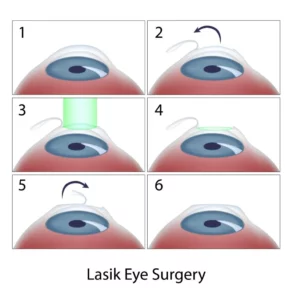If you are considering Lasik surgery, you may be wondering which type is right for you. There are three main types of Lasik surgery: traditional Lasik, all-laser Lasik, and bladeless Lasik. Each type has its own unique benefits and drawbacks. In this blog post, we will discuss the pros and cons of each type of surgery so that you can make an informed decision about which one is right for you.
Contents
What Is Lasik Surgery?
 Lasik surgery is a type of refractive surgery used to correct vision. It is the most commonly performed refractive surgery in the world. Lasik stands for laser-assisted in situ keratomileuses. This surgical procedure uses a laser to create a flap in the cornea and then reshapes the underlying tissue with another laser.
Lasik surgery is a type of refractive surgery used to correct vision. It is the most commonly performed refractive surgery in the world. Lasik stands for laser-assisted in situ keratomileuses. This surgical procedure uses a laser to create a flap in the cornea and then reshapes the underlying tissue with another laser.
This can be done on one or both eyes and is usually an outpatient procedure. The whole surgery takes about 15-20 minutes. Lasik surgery is considered to be effective for most people. In fact, over 96% of people who have Lasik surgery achieve 20/40 vision or better. If you are considering this surgery, make sure to consult with an ophthalmologist to see if you are a good candidate.
How Is It Performed?
Since its approval by the FDA in 1999, more than 800,000 people have undergone LASIK surgery. The majority of these people have been very satisfied with the results.
LASIK surgery is performed using a laser. The surgeon first creates a thin flap in the cornea. Then, he or she uses the laser to reshape the cornea. Finally, the surgeon replaces the flap. The entire procedure takes less than 30 minutes. Most people experience little to no discomfort during the surgery. And, they see an improvement in their vision almost immediately.
It is important to note that LASIK surgery is not for everyone. You will need to have a consultation with a qualified surgeon to see if you are a good candidate for the procedure. Because LASIK surgery is permanent, you will want to be sure that it is the right choice for you.
What Are The Types of Lasik Surgery?
 There are various types of Lasik surgery and each type of surgery has its own benefits and drawbacks, so it’s important to consult with your ophthalmologist to determine which type is right for you. Let’s discuss some common types of Lasik surgery in detail:
There are various types of Lasik surgery and each type of surgery has its own benefits and drawbacks, so it’s important to consult with your ophthalmologist to determine which type is right for you. Let’s discuss some common types of Lasik surgery in detail:
Traditional Lasik
It is the most common type of Lasik surgery. Traditional Lasik uses a blade to create an incision in the cornea, which is then reshaped using a laser. The process of traditional Lasik is quick and typically takes less than 30 minutes. One of the benefits of traditional Lasik is that it is often less expensive than other types of surgery.
A surgeon will make a small flap in the cornea using a blade or laser. The surgeon will then use a laser to reshape the tissue underneath the flap. After the surgery is complete, the flap will be replaced. You have to be very careful not to bump or rub your eye for at least a week after the surgery.
The most common complication of traditional Lasik is dry eyes. You may also experience some temporary side effects, such as halos around lights, glare, and difficulty driving at night. These side effects typically go away within a few weeks.
Bladeless Lasik
This is the most common type of Lasik surgery. It is also sometimes called femtosecond or Intralase surgery. The surgeon uses a laser to create a thin flap in the cornea. This flap is then lifted and the underlying tissue is reshaped with another laser. The flap is then replaced. During bladeless Lasik surgery, you will be awake but your eyes will be numbed with drops. You may see bright lights and feel a little pressure during the procedure.
There may be a few side effects associated with this type of surgery. These can include:
- Glare, halos, and double vision
- Dry eyes
- Mild discomfort or pain after the surgery
Bladeless Lasik surgery can be an effective way to correct your vision. It is important to talk to your doctor about the possible side effects and risks before you have the surgery.
PRK (photorefractive keratectomy)
This type of Lasik surgery is similar to bladeless Lasik, but there is no flap created. Instead, the surgeon uses a laser to remove tissue from the cornea’s surface. This type of surgery is often recommended for people with thin corneas or other irregularities that may make them ineligible for LASIK surgery.
Like with any surgery, there are risks involved with PRK. These include:
- Infection
- Scarring
- Light sensitivity
PRK recovery is typically slower than with other types of Lasik surgery. It can take several weeks for vision to improve and for the eye to heal properly.
Custom Lasik
 It is a type of Lasik surgery that is done using a laser to correct your vision. The surgeon will first create a map of your eye and then use the laser to change the shape of your cornea. This type of surgery is usually more expensive than other types of Lasik surgery but it can give you better results.
It is a type of Lasik surgery that is done using a laser to correct your vision. The surgeon will first create a map of your eye and then use the laser to change the shape of your cornea. This type of surgery is usually more expensive than other types of Lasik surgery but it can give you better results.
Custom Lasik works best for people who have a higher degree of refractive error. This type of surgery can also be used to treat other conditions such as astigmatism and farsightedness. As the name suggests, this type of Lasik surgery is customized to your individual needs.
ReLEx SMILE
This is a newer type of Lasik surgery that uses a laser to create a small incision in the cornea. The surgeon will then use the laser to correct your vision. This type of surgery is less invasive than other types of Lasik surgery and has a shorter recovery time.
The process is similar to traditional Lasik surgery, but the surgeon will make a smaller incision in the cornea. This type of surgery is less invasive and has a shorter recovery time. ReLEx SMILE is a newer type of Lasik surgery that uses a laser to create a small incision in the cornea. The surgeon will then use the laser to correct your vision.
The main difference between traditional Lasik surgery and ReLEx SMILE is the size of the incision. ReLEx SMILE uses a smaller incision, which is less invasive and has a shorter recovery time. If you are interested in this type of surgery, be sure to ask a professional first.
Wavefront Lasik
This type of Lasik surgery is done using a laser that is guided by a computer to correct your vision. Wavefront Lasik is said to be more precise than traditional Lasik surgery, and it can correct a wider range of vision problems. Wavefront Lasik is sometimes called custom Lasik or custom wavefront Lasik.
Moreover, this type of Lasik surgery can treat higher-order aberrations. These are imperfections in your eye that cannot be corrected with glasses or contact lenses. Wavefront Lasik can also correct some lower-order aberrations, but not all.
So, overall these are some top types of Lasik surgery. You can go for the one that you think will be the best fit according to your problem and eyes. Just make sure that you consult an expert ophthalmologist before making any final decision.
What Are The Pros And Cons?
 Now, before you make a decision, it’s important to know what the pros and cons of this surgery are. Typically, those who undergo Lasik report the following benefits:
Now, before you make a decision, it’s important to know what the pros and cons of this surgery are. Typically, those who undergo Lasik report the following benefits:
- Improved vision: This is, obviously, the primary reason people have the surgery. And, in most cases, it is successful.
- Reduced dependency on corrective lenses: After surgery, many people no longer need to wear glasses or contact lenses at all. In some cases, however, you may still need to use them for certain activities (like driving at night).
- Improved quality of life: This benefit is harder to quantify, but many people report feeling happier and more confident after surgery.
So these are a few of the potential benefits of Lasik surgery. But what about the risks? Well, some of the cons include:
- Temporary dry eyes: This is a common side effect and usually goes away within a few months. In some cases, however, it can be permanent.
- Glare and halos: You may experience these effects for several weeks or even months after surgery. In most cases, they eventually go away.
- Under- or over-correction: This is one of the most serious risks. It means that your vision isn’t as good as it could be after surgery. In some cases, you may need to have a second surgery to correct the problem.
As you can see, there are both pros and cons to Lasik surgery. So it’s important that you weigh all of the factors before making a decision. And, of course, be sure to talk to your doctor about what option is best for you.
How To Choose The Right Type Of Surgery For You?
This is a question you should ask your ophthalmologist. They will be able to give you the pros and cons of each type of surgery and help you make an informed decision. However, there are a few tips that can help you make the decision on your own.
The first thing you need to consider is what type of vision correction you need. If you have astigmatism, nearsightedness, or farsightedness, there are different types of surgery that can correct each one. You also need to think about how much correction you need. The amount of correction you need will determine what type of surgery is best for you.
Another thing to consider is your lifestyle. If you play sports or have a job that requires you to be active, you may want to choose a type of surgery that has a quicker recovery time. You also need to think about how much money you are willing to spend on surgery. Some types of surgery are more expensive than others.
Finally, you need to think about your age. If you are younger, you may want to choose a type of surgery that will not need to be repeated in the future. Lasik is a good option for people who are younger because it is less likely to cause side effects and has a lower risk of complications.
These are just a few things to consider when choosing the right type of Lasik surgery for you. Talk to your ophthalmologist to learn more about the different types of surgery and which one is right for you.
Conclusion
To conclude, types of Lasik surgery can be broadly classified into two types: surface ablation and refractive surgery. Both have their own set of pros and cons, so it is important to consult with an eye specialist to see which one would be the best fit for you. In this, there are numerous variables to take into accounts such as age, health condition, and lifestyle.
With the help of a professional, you can make an informed decision about which type of Lasik surgery is right for you. Do not hesitate to ask questions and get a second opinion if needed. Remember, this is your eyesight we are talking about!
For more information and guidance, please contact Eye Mantra. EyeMantra offers the most advanced eye surgery options including PRK, Femto Lasik, SMILE surgery, Standard lasik, and Contoura vision. If you have any questions on lasik surgery, lasik surgery cost and lasik procedure, call us at +91-9711116605 or email at [email protected].


